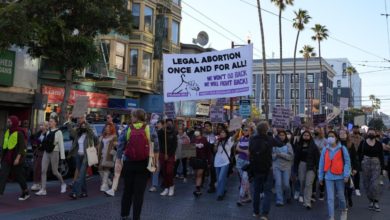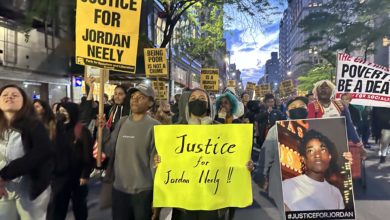Hundreds took to the streets in Los Angeles on April 28 to “Unite to Fight the War on Women.” The Los Angeles event was part of a national day of action in response to increasing attacks on women’s rights. While the crowd was energetic and diverse, the event’s message and leadership were homogeneous, leaving many who attended feeling excluded. The hardships working women and women of color face were not addressed by the speakers and organizers, nearly all of whom were white, and the only solution offered was a repeated plea to vote for and support the Democratic Party.
While it’s great to see so many women ready to fight back against attacks on our previous gains, the exclusion of working women and women of color diminishes any movement calling for unity. Women of color have a historically unique social position in U.S. society, with unique experiences and forms of oppression that we must understand and appreciate in any movement for social change.
Women of color face double oppression
A shocking study released in 2010 revealed that the average median wealth for women of color between the ages of 36-49 is only $5. By comparison, the average median wealth of white women in the same age group is $42,600—still only 61% of their male counterparts. These statistics confirm what has long been a visible feature of U.S. capitalism—that one’s place in society is based primarily on the class, nationality and gender that a person is born into.
The study was conducted by the Insight Center for Community Economic Development, analyzing data collected by the Federal Reserve in 2007. These numbers thus represent the grim economic reality prior to the current recession. A United for a Fair Economy report has since stated that the sub-prime mortgage crisis is producing the greatest loss of wealth in U.S. history for African Americans.
The study defined “wealth” as the sum of one’s income and assets subtracted by one’s debt. Using this formula, they determined that 45 percent of Black and Latina women (ages 18 to 64) had zero or “negative wealth,” which means their debt was far greater than their income and assets.
White people as a whole have certainly not escaped the devastating effects of capitalism. In fact, vast sections of white workers have practically nothing. The 23 percent of single white men and women (ages 18-64) who have zero or negative wealth amount to tens of millions of people in very real poverty.
Moreover, although the median wealth of $42,600 for single white women certainly seems large in comparison to that of Black and Latina women, it hardly amounts to a life of real security. A single white woman—for instance, a secretary—who bought a house 15 years ago with a $100,000 mortgage, and has since paid off half of it, could technically have $50,000 in “wealth” according to this study. But that does not mean she has $50,000 sitting in the bank; in fact she could have almost nothing in the bank and still be living check to check.
Medical emergencies, housing crises, or college expenses easily and frequently drain that sort of “wealth”—a portion of one’s housing equity or a modest “nest egg” in the bank. Instead of having “wealth” to fall back on, many of these workers are in fact teetering on the edge of poverty as well.
But across the board—from job discrimination to unequal pay, mass incarceration, levels of indebtedness, foreclosure rates, and more—Black and Latina women consistently receive the very worst of what capitalism has to offer, while being subjected to racist and degrading stereotypes.
In nearly 44 percent of Black families with children, a woman is the primary breadwinner. The grim economic situation thus has even more far-reaching implications in terms of addressing the community’s disproportionate poverty. The unemployment rate for Black women is nearly double that of white women and white men.
Fighting racism key to women’s liberation
Women in the United States are facing constant and increasingly severe attacks on our rights. Poor women and women of color hold the least political and economic power, are disproportionately affected by cuts to public services and assaults on reproductive rights. True equality cannot be won by a movement that excludes the voices of the most oppressed, which are in fact vital to the struggle for women’s rights and liberation.
We live in a society with the capability to provide for the needs of all and extend to all women the opportunities that only a privileged few now enjoy. This system survives in power based on the division and fragmentation of the working-class along the lines of racism, sexism and anti-LGBT bigotry. In the fight for a new type of society, working-class women and women of color can and will be at the forefront.






